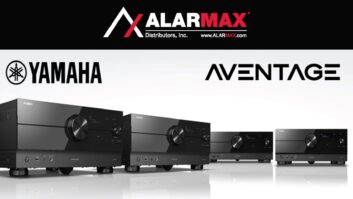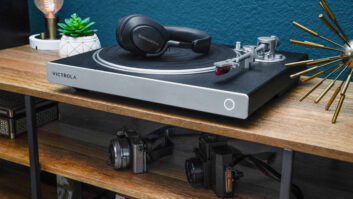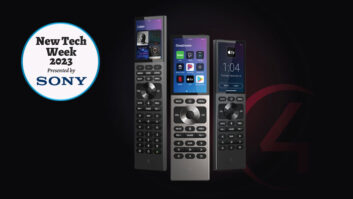Here’s a thought experiment for you: if you were to design a wireless digital multiroom music system, what would it look like? It’s a trick question, of course. Most of you, I’m sure, are inclined to believe that we have enough of the things already. From Sonos to Bluesound, to HEOS, to RIVA, to Play-Fi, the market seems to be pretty well saturated with wireless speaker systems. But Yamaha has decided that there’s room for at least one more: its nascent MusicCast system.
After spending a few weeks with MusicCast, I think the company has a compelling argument on its hands. To cover all of the components comprised by MusicCast would just about eat up my word budget here, but in short: the ecosystem encompasses preamps and AV receivers in the AVENTAGE line; RX-V receivers; HTiB systems; two-channel receivers; soundbars; active stereo speaker systems; wireless speakers; and a pair of dedicated components for use with standalone speakers and sound systems, one an integrated amp and the other a dedicated MusicCast preamp.

Yamaha’s WXA-50 MusicCast Wireless Streaming Amplifier
Although this review in particular focuses on offerings from the latter two categories (the WXA-50 MusicCast Wireless Streaming Amplifier and a pair of WX-010 Wireless Speakers, the smallest in the lineup), and the performance thereof, let’s talk first about the app a bit, since it’s the Force that surrounds and penetrates and binds the entire MusicCast galaxy together. The app not only gives you access to all of the setup functions of MusicCast (adding speakers to the home networking, naming them, creating and naming rooms, setting up sources when applicable, etc.) but it’s also the main control system for MusicCast, giving you access to music stored on iOS or Android devices, local servers, and the most of the handful of streaming music apps currently supported by Yamaha: namely Napster, SiriusXM, and Pandora. Spotify is also supported, but pressing its icon within the app instructs you to back out and launch the Spotify app, then use Spotify Connect to stream to MusicCast.
I think the best way to describe the MusicCast app would be “straightforward.” It lacks much of the deeper functionality of some of its competition, like cross-platform search and robust playlist and favorites features (they exist, but only in a limited way). But the upside to that is that I can’t imagine even the most technologically illiterate user getting lost or confused while using MusicCast.
Indeed, unless you’re linking zones, it really isn’t necessary to use the app for most music listening, since the MusicCast lineup also supports AirPlay and Bluetooth. The latter feature, in my case, made the WX-010 a really flexible addition to my bedroom. For most of the past few weeks, the little speaker has served as the output for my Amazon Echo Dot. Taking control of the speaker via the MusicCast app during those times when I did want to make that little bedside speaker part of a larger distributed music system was as intuitive and easy as one could hope for, though. My only real caveat here is that it does take the WX-010 a little longer to reconnect to Bluetooth than do other, similar speakers I have kicking around the casa.
User reviews for the MusicCast app on the iTunes store paint a picture that isn’t quite as rosy as the experience I’ve had. Multiple reports of speakers that have to be re-added to the system, interrupted streams, and problems with iOS 10 abound. I’ve done my best to recreate these problems, but haven’t had any such issues to date. Reliability has been rock solid, which may have something to do with my Access Networks-designed, enterprise-grade networking solution, or it may be because of Yamaha’s frequent updates to the app. Whatever the case, aside from a bit of sluggishness in adding speakers via Wi-Fi (and reconnecting via Bluetooth), I haven’t had any such issues with the app, despite my best efforts to trip it up.
Of course, reviewing any software experience that works reliably is a subjective experience. But evaluating hardware is a bit more objective, so let’s take a look at the handful of components provided for review in and of themselves.

Yamaha’s WX-010 Wireless Speakers
Quite frankly, if you were starting from scratch, you’d have a hard time designing a better highvalue integrated amplifier than the $500 WXA-50, even ignoring its MusicCast capabilities. With its optical audio input, USB port (A type, for use with USB storage devices), stereo audio in (and out), subwoofer out, Wi-Fi and Ethernet connectivity, and trigger in and out, it’s an incredibly versatile little amp that’s beautifully built and easy to operate. It’s also supported by an IP driver for Control4, which worked without a hitch in my system.
True, with power output rated at 55 watts per channel into 8 ohms and 105WPC into 4 ohms, it doesn’t seem overly powerful, but I used the WXA-50 to drive a pair of GoldenEar Triton One towers in a reasonably mid-sized room, and my ears gave out long before the amp ever did. It’s a fantastic sounding little piece of kit, and it’s one of the few in the MusicCast lineup to support DSD up to 5.6MHz. My only concern here is that there are no crossover settings for the subwoofer output; the left and right channels run full range no matter what, and the sub output is low-pass filtered at 250Hz.
As for the little $200 WX-010 Wireless Speakers, it’s certainly a lot more limited in terms of connectivity, boasting only a power connection and an Ethernet jack. But it’s a beautifully built and nice sounding little speaker that does the MusicCast ecosystem justice. Though bass extension is about what you would expect for a speaker of its size, low-frequency output is certainly more robust than I would have imagined, and high-frequency detail is stunning. If I have a bone to pick with the WX- 010’s audio output, it’s that midrange frequencies aren’t as neutral as one would hope for, even after liberal application of EQ via the MusicCast app.
That’s a minor complaint, though. All in all, I’m actually more impressed with the MusicCast hardware than I am its software platform, and the software is pretty much exactly what I want from a wireless multiroom speaker system.
714.522.9105
usa.yamaha.com
Kudos
Simple, straightforward, and intuitive approach to wireless multiroom audio; compatible with Yamaha AVRs; supports Hi-Res audio.
Concerns
Small native app selection; lacks the cross-platform search, robust playlist creation of some rivals.
Product Specs
WXA-50
► Rated Output Power: 105W + 105W (4 ohms, 20Hz- 20kHz, 0.06% THD, 2-ch driven), 70W + 70W (6 ohms, 20Hz-20kHz, 0.06% THD, 2-ch driven), 55W + 55W (8 ohms, 20Hz-20kHz, 0.06% THD, 2-ch driven)
► Total Harmonic Distortion (20Hz-20kHz): 0.02% (SP out)
► Signal-to-Noise Ratio: 110dB (Opt/Net/USB/ Bluetooth in)/98dB (aux in)
► File Formats: MP3, WMA, MPEG-4 AAC, WAV, FLAC, AIFF, ALAC, DSD
► Connectivity: Wi-Fi, AirPlay, Bluetooth
WX-010
► Speaker Unit: 3.5-inch woofer, 1-inch tweeter, passive radiator x 2
► Maximum Output Power: 25W (woofer 15W + tweeter 10W)
► Colors: Black, White
► Maximum Communication Range: 33 ft. (without obstructions)
► File Format: MP3, WMA, MPEG-4 AAC; up to 192kHz: WAV, FLAC, AIFF; up to 96kHz: ALAC
► Connectivity: Wi-Fi, Ethernet, AirPlay, Bluetooth







